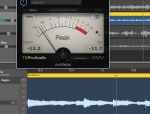keith.rogers
Well-known member
If you're recording 24-bit, you don't actually need to see a wave form. Just slap a metering plugin in GB and watch the peaks there. (I checked my GB and see I have something called TBProAudio's mvMeter - Logic has a couple digital ones but not GB, alas.) You can always put a Gain plugin on the track if you really have to bring it up after recording, but the 24-bitness of it should give you all the dynamic range you need to manipulate it.I get a lot of clipping crap going on. I'm not a violent strummer by any stretch of the imagination but I do like to play with dynamics, by the time I get a satisfactory signal/wave form on the DAW, the mic pre is up so high that anything greater than a gentle nudge causes the dreaded 'red light' to come on. ...
But, of course, you can put a compressor on going in!






